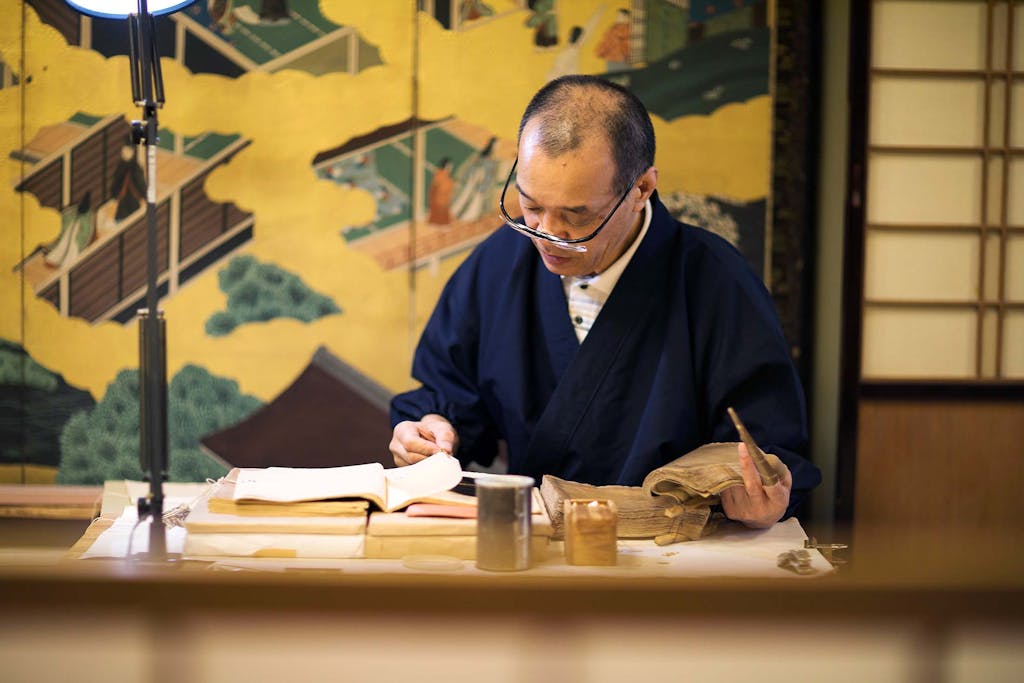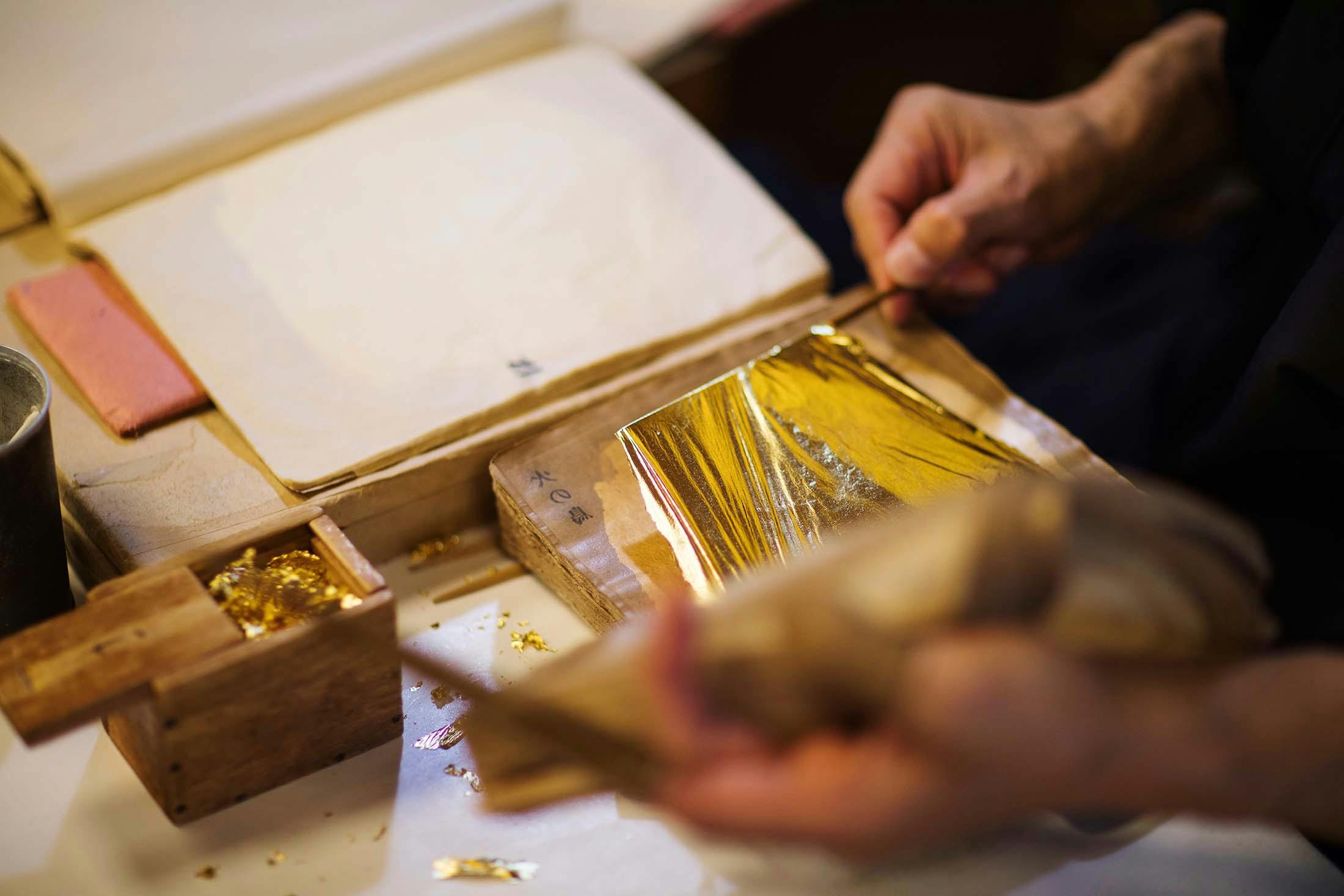Traditional Kanazawa Gold Leaf Is Still Alive in Japan
As I step into the storefront at Sakuda Gold Leaf in the Japanese city of Kanazawa, I am momentarily dazzled. Everything around me glows warmly, from the art on the wall to the intricately patterned ceramics and the cosmetics on a shelf. A staff person approaches with a small tray and offers me a cup of tea to sip while I browse. I glance down, and floating in the fragrant liquid are gleaming specks of gold. Kanazawa gold leaf is literally everywhere.
“Kanazawa is probably the most elegant city I’ve ever visited in my life,” says Amy Loewen, who lived in Kanazawa for two years and now works with Silversea as a Japan Culture Specialist. “There are gorgeous things everywhere you look.” Indeed, as I explore the city, I’m struck by the ubiquity of gold as a design element. As I stop in one of the city’s coffee shops, I notice one wall covered in gold. There are gold panels on display at the train station, and the elevators at my hotel, too, are gilded.
Let’s dive into the amazing Japanese culture and answer the question: How is gold leaf made?
The unparalleled craftsmanship of Kanazawa gold leaf
The traditional production of Japanese gold leaf, called kinpaku, has a long history in this beautifully preserved city. But how is gold leaf made, and how did it become a part of the city’s artistic legacy? The answer dates back to the 16th century. In 1593, Lord Toshiie Maeda ordered the Kaga domain, the site of the present-day Kanazawa, to produce gold and silver leaf — a long and arduous process that requires the repeated pounding of metals into impossibly thin sheets.

At the time, Kanazawa was a wealthy castle town with a strong Pure Land Buddhism foundation, and the domain’s lords put their wealth towards arts and crafts. Thus, gold leaf art was used to show off the lords’ riches and influence. It adorned temples and shrines, and was used in traditional Japanese wedding ceremonies, as well as on pottery, lacquerware and scrolls.
The Tokugawa Shogunate, Japan’s last feudal military government, began to regulate gold and silver foil in 1696. In ensuing years, gold leaf production was limited to certain areas of Japan, including Kyoto and Edo. The industry eventually ceased entirely in many localities, but Kanazawa hung on tenaciously. Today, the city makes 99 percent of all gold leaf produced in Japan. The staff person at Sakuda tells me that the gold leaf that covers Kinkakuji, the famed golden pavilion in Kyoto, was made by Sakuda artisans.
Kanazawa remained at the forefront of gold leaf craft even after the regulations were lifted. “We don’t know why other cities didn’t resume making gold leaf,” explains Akitaka Kawakami, Director of the Kanazawa Yasue Gold Leaf Museum and Professor Emeritus of Aesthetics at Kanazawa College of Art. The city’s slightly humid weather and its access to pure spring water combine to create the ideal natural conditions for producing and working with gold leaf. Psychologically, as well, the city was well suited for kinpaku creation. “We have the tradition of the artisan mind,” explains Kawakami. “The Maeda clan promoted craftworks. So in Kanazawa…we have the craftsperson mind.”
Today, in addition to religious and artistic decoration, Kanazawa gold leaf is used in local handicrafts, and the production of gold leaf has become a cultural staple in the city.

Modern-day artisans practice the gold leaf craft in Japan
The Kanazawa gold leaf process requires the experience and skill of expert artisans. As the decorative material is made through a hammering motion, they use a special kind of paper to protect the gold leaf sheets from the impact of the continuous pounding. This handmade paper — made from the ganpi plant, rice straw lye, persimmon and chicken eggs — takes several months to make and is essential to the process.
How thin is gold leaf? I feel fortunate to learn first-hand as I watch the ancient craft being practiced. To begin, an uwazumi artisan smelts pure gold with a small amount of silver and copper and presses it into thin bands. Next, he cuts the band into small pieces, placing them in between sheets of paper, before a machine pounds them to about a thousandth of a millimeter.
Finally, a kinpaku artisan completes the pounding and transferring, until the leaf reaches its final thickness of one ten-thousandth of a millimeter. At this stage, the leaf is so thin that touching it with bare hands, or breathing directly on it, can cause it to disintegrate. Artisans always wear masks and use special bamboo tools when handling it. Sakuda artisan Kenichi Teramoto, who has been working with Kanazawa gold leaf for 28 years, says it requires a light touch. “I do it instinctually. You can’t approach it too zealously,” he explains. “I do the work unconsciously.”
Kawakami tells me that if a Japanese copper 10 yen coin were made of gold, it would weigh 12 grams. “If you expand this 12-gram gold coin into one sheet of gold leaf, how wide of a leaf do you get?” he asks. He reveals the answer before anyone can respond. “Four tatami mats,” he states. Gold is quite a malleable metal, so the area of these four straw mats, which are typically used to cover the floors in traditional Japanese homes, is equivalent to about 71 square feet (6.6 square meters).
Kawakami tells me that if a Japanese copper 10 yen coin were made of gold, it would weigh 12 grams. “If you expand this 12-gram gold coin into one sheet of gold leaf, how wide of a leaf do you get?” he asks. He reveals the answer before anyone can respond. “Four tatami mats,” he states. Gold is quite a malleable metal, so the area of these four straw mats, which are typically used to cover the floors in traditional Japanese homes, is equivalent to about 71 square feet (6.6 square meters).
A hands-on experience
Observing the artisans in the workshop inspires me to try my hand at the famed Japanese gold leaf technique, and Teramoto leads the group through the process. I use an X-Acto knife to carve my design into a sheet of sticker paper, and then transfer it to the outside of a compact mirror that I’ve selected to decorate. I apply glue, then Teramoto helps me to carefully add a delicate leaf to the surface. We peel away the sticker to reveal my design crisply outlined in gleaming gold on the shiny black surface. It feels almost sacrilegious to leave bits of the sheet behind, but Teramoto explains the scraps are used for food decoration and in cosmetics.

Walking around Kanazawa, I see these particular applications: There are oil-blotting papers for your face that are dotted with gold flecks, and shops selling ice cream cones covered with a whisper-thin veneer of gold. “It feels like Kanazawa is the one city in the world where gold is free,” says Loewen. “It’s just everywhere. That’s an amazing thing.”
As I leave town, I pick up a spongy castella cake, which is sprinkled with flakes of gold leaf. I can’t wait to share a bit of Kanazawa’s glamor with everyone back home in Tokyo.
Fascinated by gold leaf’s artisan process? Experience it for yourself on one of Silversea’s Asia itineraries that calls on Kanzawa and other Japanese cities.



















